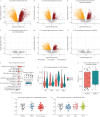IL-33 induced gene expression in activated Th2 effector cells is dependent on IL-1RL1 haplotype and asthma status
- PMID: 38843913
- PMCID: PMC11187316
- DOI: 10.1183/13993003.00005-2024
IL-33 induced gene expression in activated Th2 effector cells is dependent on IL-1RL1 haplotype and asthma status
Abstract
IL-33 response in Th2 cells is specific to asthma and represents a high risk haplotype, highlighting its role in airway wall cells. Yet, its detection is challenging in bulk asthma transcriptomes due to the scarcity of effector Th2 cells.
Conflict of interest statement
Conflict of interest: All author report that funding for this manuscript was provided by GlaxoSmithKline (GSK) and Lung Foundation Netherlands (3.2.09.081JU). M.C. Nawijn reports support for the present manuscript from the Netherlands Ministry of Economic Affairs and Climate Policy by means of the PPP allowance. M.E. Ketelaar reports an unpaid leadership position as young investigator board member of the Netherlands Respiratory Society, outside the submitted work. L. Hesse reports payment for expert testimony from Chiesi, outside the submitted work. M. van den Berge reports grants from Chiesi, AstraZeneca, Novartis, Genentech and Roche, outside the submitted work. I. Sayers reports grants from Boehringer Ingelheim and the Biotechnology and Biological Sciences Research Council (BBSRC), outside the submitted work. I.M. Adcock reports support for the present manuscript from EU-IMI; and outside the submitted work, reports grants from GSK, MRC and EPSRC, consulting fees from GSK, Sanofi, Chiesi and Kinaset, lecture honoraria from AstraZeneca, Sanofi, Eurodrug and Sunovion, payment for expert testimony from Chiesi and travel support from AstraZeneca. G.H. Koppelman reports grants from Lung Foundation Netherlands, Teva the Netherlands, European Union H2020 programme, Ubbo Emmius Foundation and Vertex, consulting fees from AstraZeneca and Pure IMS, and lecture honoraria from Sanofi Genzyme; outside the submitted work. The remaining authors have no potential conflicts of interest to disclose.
Figures


References
Publication types
MeSH terms
Substances
LinkOut - more resources
Full Text Sources
Medical
